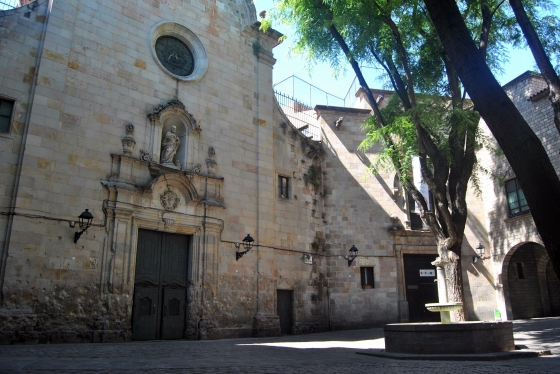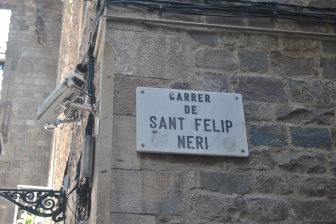
Maybe it’s because of the way that I stumbled upon it the first time.
As I have mentionned in previous posts, when I first came to Barcelona I was with a group of friends. Those friends liked to wake up late after our long nights and so in the morning I would go for walks. Sometimes I would walk through the El Born neighborhood and then walk along the water near Barceloneta beach, this was the « easy walk ». But there were morning when I felt more adventurous and I would go explore the Barri Gotic or Ciutat Vella area. This is the oldest area of Barcelona and I just loved getting lost in those tiny streets. The thing is, it’s also one of the most touristic areas in the city. So as I was trying to escape the main tourist routes, I stumbled upon this place. It is just meters away from the Barcelona Cathedral and from the busy La Rambla, yet all of that felt miles away. It was just the most peaceful place ever. That’s kind of when I knew that I had fallen in love with Barcelona.
Maybe it’s because I can never find it.
When I first « found » this place, I was just walking aroudn and had no idea of where I was or where I was going, so there was no way for me to remember how to get there. The second time I went there, it was actually a friend that brought me. I didn’t know that this was the place she was bringing me to so I didn’t pay attention to how to get there. The third time, I also stumbled on it randomly. Anyways, my point is that I never really learned how to get there. I have been there countless times before, I can place it on a map and everything yet I always have the hardest time remembering where it is. It gets better every time but because the streets are so unpredictable in Ciutat Vella I can never be one hundred percent confident in where I am going. But I think that having to « hunt » for this place every single time I want to go, makes it even more magical and rewarding when I do.
Maybe it’s because no one knows it, yet everyone does.
When you are sitting in Plaça Sant Felip Neri, you can sometimes feel all alone in the world. Not in a depressing way. I mean this in the « zen » way. This place can be so peaceful and empty at times that you feel like you are one of the first to ever set foot there. You feel like you and maybe a handful of other people are in on this great secret about this place. But the truth is that this is a very known spot. Firstly, there is a school there, a restaurant and hotel, a soap shop, a church and a museum. Those are enough attractions to bring a whole lot of people. And on top of that this place has a very interesting history – don’t worry I’ll talk about it later – which means that tour guides often stop here when showing the Ciutat Vella neighborhood to tourists. (Somehow those guys don’t have a hard time finding this spot.) When I talk to people who are either from Barcelona or have lived in Barcelona they all tend to know about this spot or mention it as part of the things that I must see during my stay. It was even featured in Vicky Cristina Barcelona. So it’s more like a not-so-secret secret spot.
Maybe it’s because it is calm.
Other than when tour guides come in or when the school children are playing this place is super quiet. I know that I am making it sound like the calm is the exception rather than the rule, but I promise you it is the other way around. This place is always super calm. You know how when some people want to relax they play these CDs with sounds of nature, things like waves, a storm or a river. Well this place is better. Here you get to hear nothing but the sound of the fountain and your own thoughts. Everything around you is beautiful, from the buildings to the trees. There is some sunlight but not too much that it becomes bothersome. You simply have no reason not to be at peace.
Maybe it’s because of its history.
You might have noticed on the picture above that the walls of the church in the picture above are not exactly « smooth ». That’s because this is one of the only remaining buildings that did not get it’s façade renovated after the bombings of the Spanish Civil War. The Barcelonans wanted to keep it intact as a reminder of the tragic event that happened here. During the Civil War many people took refuge in churches and bunkers around the city. This church was no exception. But in January 1938, a bomb hit the plaça it killed 42 people including 20 children. The sadness of that tragedy can be felt when you are there. But the fact that they decided to put a children’s school here is also an amazing symbol of strength and hope.
An other little known fact about this place is that Gaudi regularly attended the church in Plaça Sant Felip Neri. Apparently he was running to get to this church when he fatally hit by a tram in 1928.
Maybe it’s because of the soap shop.
One of my favorite things about this place is that there is a small soap factory/shop called Sabater Hemanos. It was recommended to me by a friend and I have been going back there every since. To be completely honest, ever since that first trip to Barcelona I have pretty much been using their soaps any time I can. They smell amazing and they last forever! Sometimes they put some soap petals in the fountain which makes the entire plaça smell amazing!
Maybe it’s because of none of these reasons. Maybe it’s because of all of them.

















